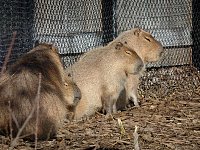
Sometimes chance conversations lead to interesting travels.
Sometimes it's not quite as exciting.
By pure coincidence, someone mentioned the renovated Paris Zoo to me.
They had closed it down for a couple of years, rebuilt almost everything from scratch and re-opened in 2014 with a new concept - instead of grouping animals by type (big cats, bears, birds, reptiles and so on), the exhibits were now grouped by place of origin (well, 'biozones').
So there was a Madagascar zone, a Sahel-Sudan zone, a Patagonia zone, a Europe zone and a Guiana zone.
That seemed like an interesting concept and a detour from the way 'classical' zoos work.
A couple of days later, I found that I would be in Paris the following week. So, given that I just learned about the interesting zoo concept, I decided to stay a bit longer and add a day of vacation and visit the zoo.
And I can see what they are trying to do - but I wasn't really impressed.
The concept makes sense - get away from the standard parade of 'must see' animals and 'fierce creatures' where every zoo must have a lion, a grizzly bear, a rhino, an orangutan and an elephant. And concentrate on groups of animals that fit together from a zoologist point of view.
It probably also makes the 'maintenance' of the animals easier - once you provide suitable climatic and environmental conditions for a specific biotope, you can use that for all the animals from this region. No need to provide different environments from one patch to the next, just because you need to put desert foxes next to artic foxes in the 'fox area'.
Also, if you think about possible future re-population of animals into protected environments in their original home regions, it's good to have a 'matching set' of animals. And you can train biologists with knowledge about specific regions and biotopes as opposed to zookeepers, who need to know what the individual animal species need.
So, for a conservationist's point of view, this might work out well.
For a zoo - not so much.
One of the problems, and that's not one due to their new concept, but because it's a "modern zoo" and tries to avoid the old "animals behind bars" image, is that most enclosures have one big 'show window' but also provide some region that gives the animals some chance to get away from visitors.
In many places, the window is the only place where the animals can be seen. Most of the other sides, with the traditional fences, are blocked from the path by plants.
An idea that works on paper - but not so good on a cold and damp February morning when dew covers the big glass windows.
And, depending on the direction the enclosure is in, if the sun is still low, you are more likely to see reflections in the glass than the animal behind it.
The main problem with the 'region' approach of the zoo, however, is that you can't really mix the animals in one enclosure.
It's quite obvious why you can't put lions, gnus, rhinos and alligators into the same enclosure, even though they live together in the wild.
But it also doesn't work for most animals that are unlikely to harm each other for all kinds of reasons.
Mostly it has to do with the visibility of the animals.
If you have a nice are where you let a couple of giant turtles roam, you can of course also include a handful of chameleons, some non-venomous snakes, a couple of birds and maybe a couple of lemurs, but in any enclosure that's larger than the usual terrarium, visitors won't be able to spot any of the chameleons. Or the ants.
Feeding would also be a problem, since the quicker animals (or climbing animals) would snap up the stuff from the ground. Not a problem in the real environment, but if you drop some salad leafs for the turtles on the ground and some fruit for the lemurs into the tree, the lemurs would probably grab both before the turtles even notice.
So while the individual enclosures are grouped in one thematic section, most of the animals are still in their individual corral, cage or terrarium.
Which means, as far as visitors are concerned, the zoo just looks like any other zoo, only that animals are clustered in a different way.
Admittedly, there are one or two places where the concept works. One area has rhinos, zebras and kudus (some sort of antelope), but there are a number of pillars in the enclosure where the antelopes can pass through, but the rhinos can't, so the antelope can retreat into their own space, but the separation between 'animal mix' and 'gazelles only' area isn't that noticeable.
But that can be and has been done in other zoos, regardless of concept.
The only real advantage of the concept is that it allows the zoo to get away from the 'standard' assortment of animals - the Paris Zoo has no tigers, no apes and no kangaroos. So it can be more selective as it does not need to cater to set expectations. There's no need to compete with other zoos in that area.
So it's all laudable and well meant, but as a visitor to the zoo I was less impressed than I assumed I would be - I had expected something more spectacular, more noticeable different, more radical.
The big artificial rock still looks impressive, but that has been there since the zoo originally opened eighty years ago.
But at least now I know that their sea lions are regularly cleaned...
In any case - nice enough as a city zoo, but it didn't really justify staying in Paris for a day.